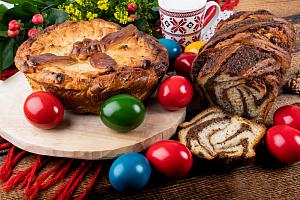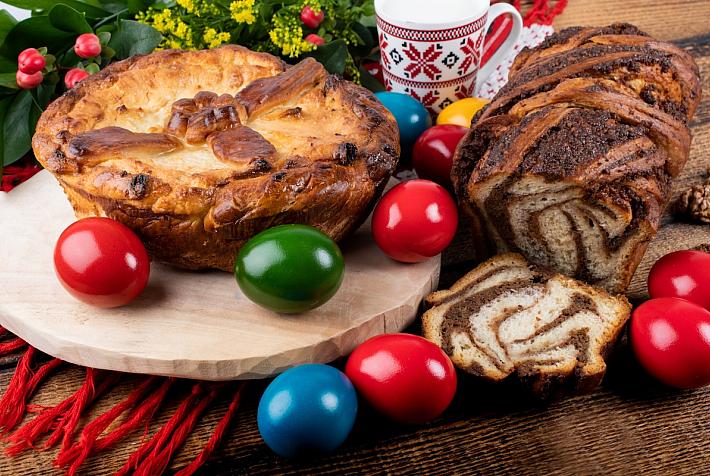Easter in Romania: Traditional recipes to try at home

We’ve listed the recipes for the most popular traditional foods below, you just have to choose your favorite(s) and put your cooking skills to work.
The Easter menu in Romania may differ from region to region, but there are some traditional foods that almost all Romanians cook in this period. The painted eggs, for example, are probably the most popular, but the lamb meat is also a star of the Easter menu, and the sweets such as pasca or cozonac will be on the table as well.
Painted eggs
The eggs, which are one of the most common foods in the world, become very special in Romania on Easter, being a symbol of this religious holiday. They are usually made on the Holy Thursday (the Thursday before Easter), and the recipe is quite easy.
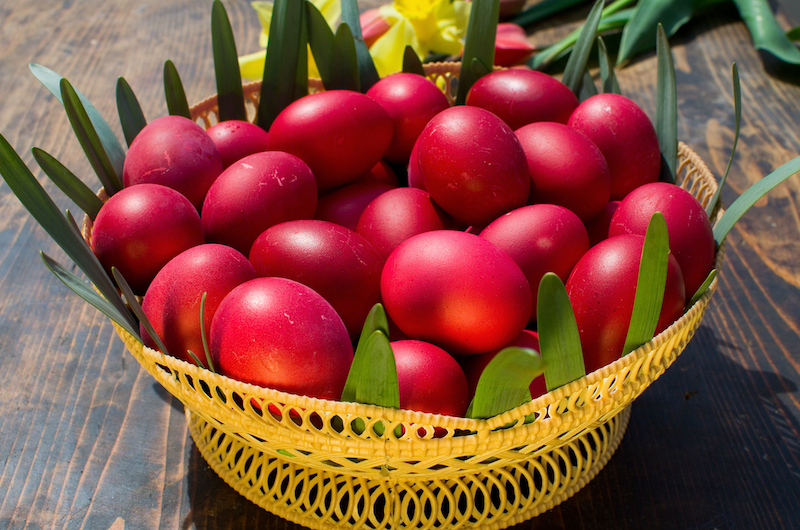
Ingredients:
- eggs
- powdered egg dye (it can be bought from the supermarket, in various colors)
- vinegar
- cooking oil
Wash the eggs with hot water and dish soap, then rinse them well. Place them in a saucepan, cover them with water and let them boil for about 10 minutes (we need hard boiled eggs for this recipe).
In the meantime, prepare the dye following the instructions on the package (add 2 tablespoons of vinegar). Add the hard boiled eggs (while they are still hot) and let them sit in the dye for a few minutes (according to the instructions on the egg dye’s package). Remove the eggs, place them on paper towels and let them dry. Once dry, brush with cooking oil for a nice sheen.
In some parts of Romania, local artisans create complicated embroidery on the painted eggs, using wax and various colors and motifs.
Drob de miel (lamb haggis)
It is customary in Romania to eat lamb on Easter, and one of the most popular dishes is drob de miel.
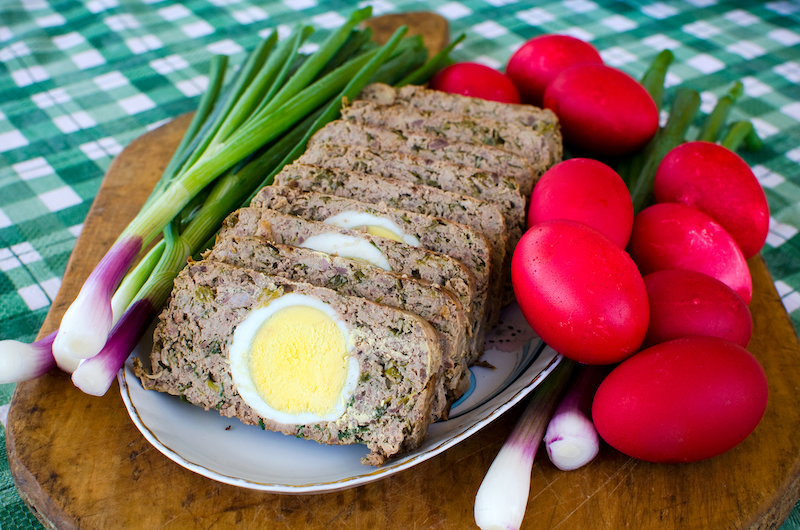
Ingredients:
- about 500 grams of lamb organs (heart, lungs, liver, kidneys)
- 2 boiled eggs
- 2 raw eggs
- 1 slice of bread dipped in milk
- 4-5 spring onions
- 1 bunch of parsley
- 1 bunch of lovage
- 1 bunch of fennel
- 1 spoon of sour cream
- salt and pepper
- lamb caul (the fatty membrane surrounding the internal organs) or a pasta sheet (the one for noodles)
- oil to grease the pan
Boil the organs in water with a pinch of salt. Drain and cool, and when chilled, mince them in the mincer, together with the slice of bread dipped in milk. Add the raw eggs, the sour cream, salt and pepper, the minced greenery and the minced onion (the green part as well). Mix everything thoroughly, with the aid of a (wooden) spoon.
Meanwhile, get a pan (Romanians usually use a four-square pan) and grease it with oil (or butter). Wash the lamb caul and lay it inside the pan, making sure it covers its margins too, so the blended contents will be entirely covered. If using a sheet of pasta, it must be well oiled. Anyone who isn't big fan of a strong lamb odor should use the pasta sheet.
Add half of the contents earlier prepared, then in the middle put the two boiled eggs, either cut in two or in four. Put the remainder of the mix, level it with the help of the back of a spoon and turn the margins of the lamb caul over the mix.
Bake it in the oven for about 30 minutes. Serve it sliced, with green onion and radishes.
Pasca (the traditional Easter cheesecake)
Pasca is one of the most common and loved Easter dishes in Romania. It is a delicious cheesecake that mainly contains sweet cheese and raisins. Its name comes from Paste (Easter).
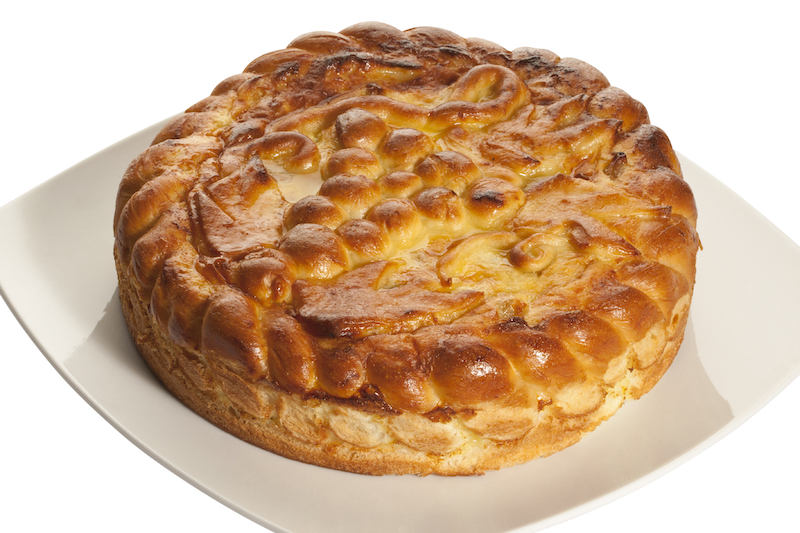
Ingredients:
Dough
- 300 g flour
- 2 egg yolks
- 50 g sugar
- 100 ml warm milk
- 100 g cottage cheese/farmer’s cheese
- 50 g butter minimum 80% fat
- a pinch of salt
- zest from 1 lemon
- vanilla extract
- 20 g fresh yeast
Cheese filling
- 2 egg whites
- 200 g cottage cheese/farmer’s cheese
- 50 g butter minimum 80% fat
- 100 g sugar
- 50 g raisins
- 50 g sour cream
- 30 g rice flour (or white flour)
- a pinch of salt
- vanilla extract
- zest from 1 lemon
+ 1 egg for brushing
In a bowl, add the milk, the sugar, the yeast and the other ingredients (except for the flour) and mix them well. Gradually add the flour and start kneading the dough (you should get a smooth, slightly sticky dough). Cover the dough with plastic wrap and leave it in a warm place to rise, until it doubles in size.
Then, divide the dough in two (one third for the base and two thirds for the braided circle). Take the smaller dough piece and place it in the pan (it should cover the bottom of the pan - we chose a 28 cm springform pan for this recipe).
Take the bigger piece and divide it in two, then form two thin ropes (they should be as long as the circumference of the pan). Braid the two ropes and form a circle, and then place the braided circle in the pan. Put it aside for about 15 minutes, covered with a kitchen towel.
Preheat the oven to 180 degrees Celsius.
For the filling, start whipping the egg whites with a pinch of salt until they become foamy. Mix the rest of ingredients, add the whipped whites and stir to combine.
Beat the other egg and use it to brush the dough in the pan. Then pour the cheese filling in the middle of the dough.
Bake the pasca for 20 minutes at 180 degrees Celsius and then for another 10-15 at 150 degrees Celsius.
Slice it only after it cooled completely.
Cozonac (sweet bread)
The cozonac is a traditional desert cooked for Easter, but the Romanians also make it for Christmas or other special occasions.
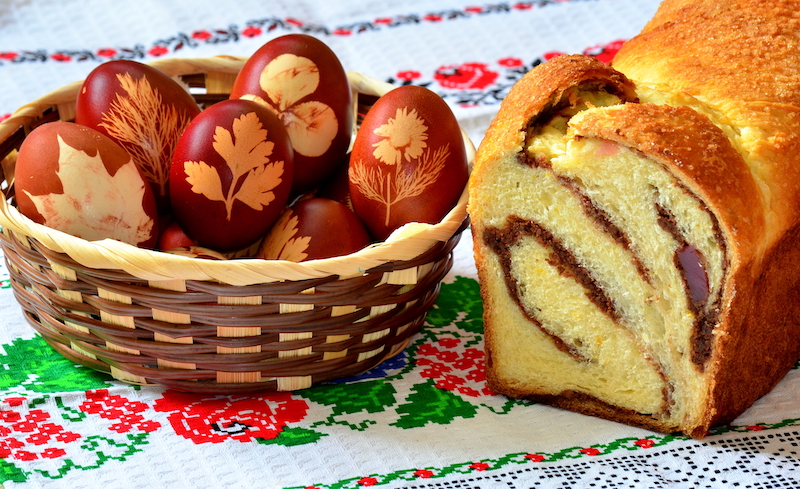
Ingredients:
Dough
- 1 kg flour
- 50 g fresh yeast
- about 400 ml warm milk
- 250 g sugar
- 4 eggs
- 150 ml of sunflower oil or 100 ml of sunflower oil and 100 g butter
- 3 small packages of vanilla sugar or 1 vanilla bean
- zest from 2 lemons and 1 orange
- 15 g salt
Filling
- 300 g Turkish delight
- 150 g finely chopped walnuts
- 100 g sugar
- 50 g cocoa
+ an extra egg and a bit of milk for brushing
Mix the yeast with 1 teaspoon of sugar and 100 ml of milk. Sprinkle a bit of flower on top and let it sit for 10 minutes.
In a separate bowl, mix the eggs with the rest of sugar and the vanilla (or vanilla sugar) for about 5 minutes. Add the yeast mixture, the rest of milk, lemon and orange zest, and 500 g of flour. Mix everything for about 5 minutes. Add the rest of flour and the salt.
When all the ingredients are well combined, start kneading the dough, while gradually adding the butter and oil mixture (or simply the oil) to the dough. You have to knead for at least half an hour.
Cover the bowl with dough with cling film and leave it in a warm place to rise, for about one and a half hours.
For the filling, cut the Turkish delight into small pieces. Mix the sugar, cocoa, and finely chopped walnuts.
After the dough has risen, split it into 4 equal balls. Take each ball and spread it in a rectangular form on an oiled working surface. Spread 1/4 of the filling mixture over each rolled dough ball, then spread some Turkish delight bits, and then roll it up. Repeat with the other three dough balls.
Put two rolls over each other in an X form, and start braiding from the middle toward the ends. Place the sweet breads in loaf pans topped with baking paper. Leave them to rise until they double in size.
Preheat the oven to 180 degrees Celsius. Mix the yolk with a bit of salt and a bit of milk. Use this mixture to brush the two cozonac just before placing them in the oven. Bake them for 20 minutes and then cover them with baking paper. Bake for another 20-25 minutes (depending on your oven). Check if they’re done by inserting a toothpick into the center – if it comes out clean, the cozonac is ready
When they’re ready, take them out of the oven and let them cool in the loaf pan.
Take the cozonac out of the pan, cut it into slices, and serve it simple or with milk.
The recipes can vary from one region to another, or even from household to household, especially for the two desserts.
newsroom@romania-insider.com
(Opening photo: Ncristian/Dreamstime.com)






